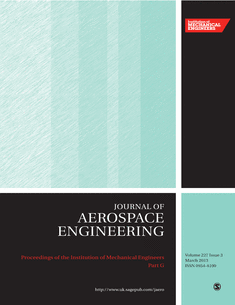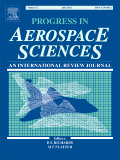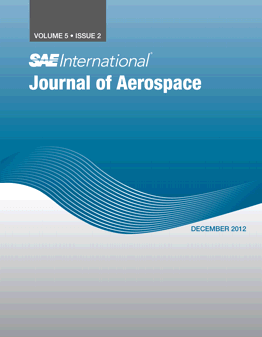
PROCEEDINGS OF THE INSTITUTION OF MECHANICAL ENGINEERS PART G-JOURNAL OF AEROSPACE ENGINEERING
Scope & Guideline
Fostering Collaboration in Aerospace Research
Introduction
Aims and Scopes
- Aerospace System Design and Optimization:
Research in this area encompasses the design and optimization of various aerospace components and systems, including aircraft, spacecraft, and propulsion systems. This includes the application of advanced computational methods and optimization techniques to enhance performance and efficiency. - Control Systems and Flight Dynamics:
This scope focuses on the development and analysis of control systems for different types of aerospace vehicles. This includes guidance, navigation, and control strategies for UAVs, aircraft, and spacecraft, as well as studies on flight dynamics and stability. - Aerodynamics and Fluid Mechanics:
Research related to the aerodynamic characteristics of aircraft and spacecraft, including studies on airflow, drag reduction, and turbulence modeling. This area often involves both experimental and computational fluid dynamics (CFD) approaches. - Material Science and Structural Integrity:
Investigations into the materials used in aerospace applications, focusing on their mechanical properties, fatigue life, and performance under various conditions. This includes studies on composite materials and structures to improve durability and reduce weight. - Fault Diagnosis and Reliability Engineering:
This area addresses the reliability and safety of aerospace systems, focusing on fault detection, diagnosis, and fault-tolerant control strategies. It emphasizes the importance of maintaining operational integrity in the face of component failures.
Trending and Emerging
- Artificial Intelligence and Machine Learning Applications:
There is a marked increase in the application of artificial intelligence (AI) and machine learning (ML) techniques for various aerospace problems, including trajectory optimization, fault diagnosis, and autonomous navigation. This trend highlights the growing importance of data-driven approaches in aerospace engineering. - Sustainable and Green Aviation Technologies:
Research focusing on sustainable aviation practices, including the development of hybrid-electric propulsion systems and strategies for reducing emissions, is on the rise. This reflects a broader industry shift towards environmental responsibility and sustainability. - Advanced Materials and Manufacturing Techniques:
Emerging research on advanced materials, including composites and additive manufacturing techniques, is gaining prominence. This includes studies on the performance and integration of new materials into aerospace structures to enhance performance and reduce weight. - Robust Control and Adaptive Systems:
There is an increasing focus on robust and adaptive control strategies for managing uncertainties in aerospace systems. This trend encompasses the development of advanced control algorithms that can maintain performance despite variations in system dynamics or environmental conditions.
Declining or Waning
- Conventional Propulsion Systems:
Research focusing on traditional propulsion systems, such as turbojet and turbofan engines, is seen to be declining. The increasing interest in alternative propulsion methods, such as electric and hybrid systems, indicates a shift in focus toward more sustainable technologies. - Basic Aerodynamics without Advanced Methods:
Studies that rely solely on basic aerodynamic principles without the integration of advanced computational methods or experimental techniques are becoming less common. The trend indicates a preference for more sophisticated analyses that leverage modern technology. - Static Structural Analysis:
There is a noticeable decrease in papers focusing solely on static structural analysis of aerospace components. This may be due to a growing emphasis on dynamic analysis and the integration of fluid-structure interaction studies.
Similar Journals

PROGRESS IN AEROSPACE SCIENCES
Pioneering breakthroughs in aerospace sciences since 1961.PROGRESS IN AEROSPACE SCIENCES is a prestigious journal published by PERGAMON-ELSEVIER SCIENCE LTD, recognized as a leading platform in the field of aerospace engineering, mechanical engineering, and mechanics of materials. With an impressive history dating back to 1961, the journal covers a wide spectrum of topics pivotal to advancing aerospace technology and innovation. Its recent ranking as Q1 in multiple engineering categories underscores its significance, ranking #1 in Aerospace Engineering and placing within the top 20 percentile in both Mechanical Engineering and Mechanics of Materials, according to Scopus assessments. Researchers, professionals, and students looking to engage with high-impact research will find PROGRESS IN AEROSPACE SCIENCES an invaluable resource, offering insights into cutting-edge developments and methodologies. Although it does not operate under an open-access model, the journal upholds rigorous peer-review standards, ensuring that the published content meets the highest academic integrity. Situated in the United Kingdom, it plays a critical role in fostering international collaboration and knowledge-sharing in the aerospace sector.

Advances in Aerodynamics
Innovating Solutions in Aerospace Engineering.Advances in Aerodynamics is a premier scholarly journal published by SPRINGERNATURE, dedicated to the innovative fields of Aerospace Engineering, Civil and Structural Engineering, Mechanical Engineering, and various aspects of Modeling and Simulation. Since its inception in 2019, this open-access journal has rapidly gained recognition, achieving a commendable Q1 ranking in several engineering categories as of 2023. With its compelling focus on pioneering research and advancements in aerodynamics, it serves as an essential platform for original research articles, reviews, and technical notes that address both theoretical frameworks and real-world applications in sustainable engineering practices. With an impact factor fostering its prominence and visibility in the academic community, the journal provides accessible content that fosters knowledge dissemination among researchers, industry professionals, and students alike. Situated in Singapore and with a commitment to rigorously peer-reviewed research, Advances in Aerodynamics is positioned to play a pivotal role in shaping the future of aerodynamics and its applications across various engineering disciplines.

Aerospace
Inspiring the Next Generation of Aerospace InnovatorsAerospace is a premier open-access journal published by MDPI, established in 2014 and dedicated to the dynamic field of aerospace engineering. With an impressive Q2 ranking in the 2023 category of Aerospace Engineering, this journal is a vital resource for researchers, professionals, and students interested in advancements and innovations in aerodynamics, avionics, propulsion, and more. Operating from Switzerland, Aerospace provides a platform for the dissemination of high-quality research articles and reviews, contributing to the ongoing dialogue in the aerospace community. This journal not only enhances visibility through its open access model but also ensures that critical knowledge is freely available, fostering collaborative efforts and inspiring the next generation of aerospace engineers. With a Scopus ranking of #60 out of 153 in the Aerospace Engineering category, it plays a significant role in shaping the future of aviation and space exploration.

MECHANICAL ENGINEERING
Exploring the Depths of Mechanical Principles and PracticesMECHANICAL ENGINEERING, published by the esteemed American Society of Mechanical Engineers (ASME), is a vital resource for professionals and researchers in the field of mechanical engineering. With a rich history that spans several decades, this journal has been pivotal in disseminating innovative research and advancements from 1968 to 1998 and from 2002 to 2024, fostering a deeper understanding of complex engineering principles. Although currently not an open access journal, it offers subscription-based access to its high-quality articles, enhancing the field's scholarship. As evidenced by its Q4 ranking in mechanical engineering and a current Scopus rank of #580 out of 672, MECHANICAL ENGINEERING serves as a platform for valuable contributions, albeit it is positioned among its peers within the 13th percentile. This journal is a beacon for those committed to staying at the forefront of mechanical engineering research and practice, encouraging discourse that shapes the future of the discipline.

SAE International Journal of Aerospace
Catalyzing Ideas for Tomorrow's Aerospace Challenges.The SAE International Journal of Aerospace, published by SAE International, serves as a critical platform for innovative research and advancements within the field of aerospace engineering. With an ISSN of 1946-3855 and an E-ISSN of 1946-3901, this esteemed journal contributes significantly to the body of knowledge in the aerospace sector, boasting a convergence span from 2008 to 2024. While currently categorized in Q4 of Aerospace Engineering, the journal is dedicated to fostering emerging ideas, technologies, and methodologies that could eventually elevate its standing. Although it does not offer open access options, the journal ensures wide dissemination of its well-curated articles to aid researchers, professionals, and students in staying abreast of the latest developments and trends. Given its distinct focus and commitment to the aerospace community, the SAE International Journal of Aerospace plays an essential role in bridging theory and practice, making it a valuable resource for those within this vital and evolving field.

Mechanika
Connecting Global Minds Through Open AccessMechanika is a prominent open-access journal published by Kaunas University of Technology in Lithuania, with an ISSN of 1392-1207 and E-ISSN 2029-6983. Since its transition to open access in 2007, the journal has successfully facilitated the dissemination of vital research findings within the field of condensed matter physics, carving a niche for itself in a competitive academic landscape. Despite currently being categorized in the Q4 quartile for its impact in this area, Mechanika aims to foster advancements by providing a platform for innovative studies, reviews, and applications. As researchers, professionals, and students engage with its content, they will find an array of studies that push the boundaries of understanding in mechanics and related disciplines. Situated in the vibrant academic milieu of Kaunas, Mechanika is committed to quality, accessibility, and fostering scientific dialogue among the global academic community.

JOURNAL OF AEROSPACE ENGINEERING
Advancing aerospace innovation for a soaring future.JOURNAL OF AEROSPACE ENGINEERING, published by the American Society of Civil Engineers (ASCE), is a premier scholarly journal that serves as an essential resource for engineers and researchers in the aerospace engineering domain. With an ISSN of 0893-1321 and an E-ISSN of 1943-5525, this journal has been dedicated to advancing knowledge since its inception in 1988 and will continue to do so through to 2024. The journal is categorized in the Q2 quartile across multiple engineering disciplines, including Aerospace Engineering, Civil and Structural Engineering, Materials Science, and Mechanical Engineering, reflecting its reputable standing in the community. The impact factor speaks to its influence and relevance, making it a critical reference for ongoing research and innovations. Although this journal does not offer open access, it ensures that its content is comprehensive, engaging, and peer-reviewed, targeting a diverse audience of professionals, academics, and students involved in the fields of aerospace engineering and related disciplines. The journal actively contributes to shaping future engineering practices, showcasing cutting-edge research and fostering collaboration among discipline experts.

Journal of the Brazilian Society of Mechanical Sciences and Engineering
Empowering knowledge through cutting-edge discoveries.The Journal of the Brazilian Society of Mechanical Sciences and Engineering, published by Springer Heidelberg, is a pivotal platform dedicated to disseminating cutting-edge research in the realm of mechanical sciences and engineering. With an ISSN of 1678-5878 and an E-ISSN of 1806-3691, this journal showcases innovative findings across various categories, including Aerospace Engineering, Automotive Engineering, and Industrial and Manufacturing Engineering. Notably positioned in the Q2 and Q3 quartiles of its fields as of 2023, the journal highlights the importance of rigorous scientific inquiry, contributing significantly to the understanding and application of engineering principles globally. With a Scopus rank reflecting strong performance in multiple engineering disciplines, this journal serves as an invaluable resource for researchers, professionals, and students seeking to advance their knowledge and explore the frontiers of mechanical sciences. The journal covers a broad range of topics and aims to facilitate collaboration and synergy among experts in the field, enhancing the overall impact of mechanical engineering research.

JOURNAL OF THE AMERICAN HELICOPTER SOCIETY
Advancing Aerospace Frontiers with Every Issue.The Journal of the American Helicopter Society, published by the American Helicopter Society Inc., serves as a leading platform for innovative research in aerospace engineering, mechanical engineering, and materials science. With its ISSN 0002-8711 and E-ISSN 2161-6027, this esteemed journal has been disseminating pivotal findings since 1969 and continues to capture cutting-edge advancements in the field. The journal is distinguished by its position in the top quartile (Q1) for Aerospace Engineering and Mechanics of Materials, and Q2 for Materials Science (miscellaneous), reflecting its rigorous standards and significant influence on both academia and industry. Researchers, professionals, and students benefit from access to comprehensive studies, case analyses, and reviews, all aimed at enhancing knowledge and fostering innovation in rotary-wing aircraft technologies. As the field continues to evolve through new challenges and innovations, the Journal of the American Helicopter Society remains a vital resource for those committed to advancing helicopter design, operation, and safety.

International Journal of Micro Air Vehicles
Connecting Scholars and Professionals in MAV TechnologyThe International Journal of Micro Air Vehicles, published by SAGE Publications Ltd, stands as a pioneering platform for cutting-edge research in the rapidly evolving field of micro air vehicle (MAV) technology. With an ISSN of 1756-8293 and an E-ISSN of 1756-8307, this journal caters to a diverse readership, including aerospace engineers, researchers, and industry professionals who are at the forefront of innovation in aerospace engineering. It holds a commendable position within the Q3 category of Aerospace Engineering for 2023 and is ranked 65th out of 153 in Scopus, placing it in the 57th percentile among its peers. As a vital resource since its inception in 2010, the journal emphasizes advancements in design, performance, and applications of MAVs, while facilitating knowledge sharing and collaboration across disciplines. Although it operates on a subscription model, the journal ensures accessibility of pivotal research findings for professionals and scholars alike, aiming to shape the future of aerospace applications through rigorous academic inquiry.